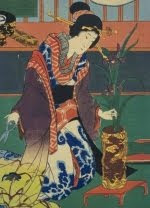“Americans are excellent at putting together combinations of color and material that Japanese people would never think of", says grandmaster of Sogetsu ikebana Yokou Kitajima. Since moving from Japan to the US in the 1970s he's been teaching ikebana to Americans and should know from experience what he is talking about. You can read the whole interview with Yokou Kitajima on the Discover Nikkei website, a project that is documenting and sharing the life of Japanese people living outside of Japan.

Yokou Kitajima says he's impressed with his students ideas that he himself, being a Japanese, would not be able to come up with. "I believe these are not qualities that can be taught, but an ability that they possess naturally", he continues. He also relates the differences to the amount of flowers and plant materials that are available in different parts of the world. In California, where Mr. Kitajima lives, there is a wide range of materials available that allows for other opportunities than in Japan. He sees the differences in national consciousness and climate as an enrichment to the world of Sogetsu ikebana: “When I show it [a piece created in America] to a person from Japan, I want them to think, “Ah, indeed, American Sōgetsu is different.” I want it to be a piece with even more freedom of creativity—not just something big, but a piece of work that would really intrigue them.”
As a person living in Norway I find Mr. Kitajima's reflections on ikebana materials and national consciousness quite interesting. In California you can cut impressive flowers, like Bird of paradise flowers, in your back yard. In Norway it's much more limited what you can grow outdoors. The cold season with frozen ground and bare branches on the trees lasts for at least one-third of the year - I'm sure this also has an impact on people living here.
When I look at the expression of Norwegian ikebana arrangements compared to creations by ikebanists from further south in Europe and other parts of the world, the importance of our culture and natural surroundings becomes quite obvious. In Norway we are using less green materials and flowers. As a result the ikebana arrangements are less decorative and maybe more fragile and cut to the bone. To me celebrating the differences becomes part of being "here and now" and accepting things as they are rather than pretending to be somewhere or someone else. I will definitely keep thinking about the meaning of nationality and surroundings as I continue my ikebana work.
I came across the Discover Nikkei website preparing for a trip to Los Angeles in a couple of weeks. I would be happy to hear from you if you now of any must do's in the area. On the website there are several other interesting articles on Japanese culture that you might want to read, including a portrait interview with Haruko Takeichi, also a high ranking Sogetsu ikebana master in Los Angeles.
Photo of Yokou Kitajima borrowed from Sogetsu Los Angeles Branch.












2 comments:
Hi. I like your blog! Ikebana pictures are great (I mean really great!), and I enjoy reading the comments, too. I read so many Ikebana blogs every day (of course after work…) , mostly in Japanese, but I will definitely read your blog going forward.
I have been learning Ikebana for about a year now under Yokou Kitajima sensei in Los Angeles. One day, I want to be a teacher.
Congratulations. I'm sure Mr Kitajima is a good teacher. I read a lot of ikebana stuff on the net as well. Unfortunately I don't read Japanese so I follow only a few Japanese blogs. It's interesting to look at the pictures :-)
Post a Comment